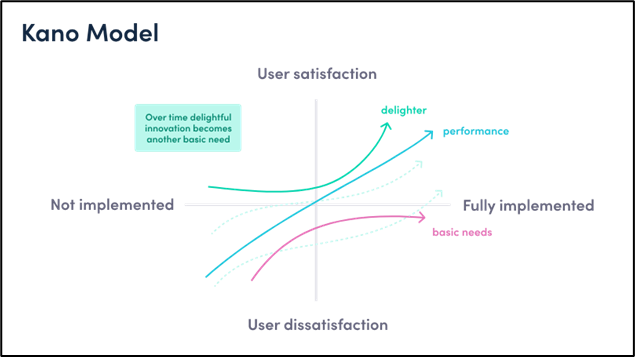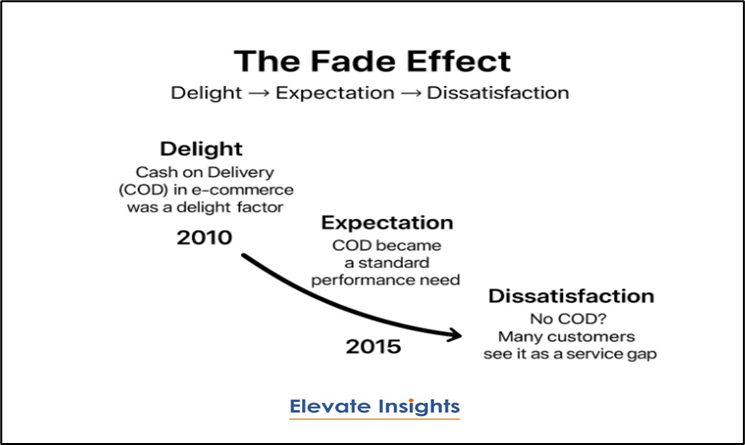Building Delightful Products: Kano Model
- snehagudela1
- Sep 10
- 4 min read
In user research, we often assume that improving every feature automatically leads to happier customers. But reality is trickier—not all features are created equal in the eyes of consumers. Some create delight, others are just expected, and some don’t matter at all.
To better understand this, let’s learn about the Kano Model which is one of the best tools for making sense of this complexity by explaining how different product or service features influence customer satisfaction and loyalty.
What is the Kano Model?

Developed by Professor Noriaki Kano in the 1980s, the model categorizes features into three main types based on their impact on customer satisfaction. Let's quickly recap what this model is all about.
1. Must-Have Attributes
These are the basic needs, or we can say the hygiene factors. If they’re missing, customers are dissatisfied, but having them doesn’t create delight. Let's take an example of a food delivery app; timely delivery is a must-have, nobody will thank you for being on time, but they’ll complain loudly if you’re late.
2. Performance Needs/Attributes
These create a direct correlation between performance and satisfaction—the better you deliver, the happier customers are, and the worse you deliver, the angrier your customer will be. For example, in an e-commerce site, faster delivery times usually mean higher satisfaction.
3. Attractive Attributes/Delighters
These are the unexpected features that surprise and delight customers. They don’t miss them if absent, but when present, they can create strong differentiation. For example, pre-approval of entry notification on the MyGate app as soon as your Swiggy order has been picked up, or MakeMyTrip’s free hotel room upgrades.
Over time, the model has also helped in identifying how these attributes relate to each other. For example,
1. Category norms are important in shaping must-have attributes:
In a recent study for an airline company, during the usability testing, we noticed as users tried to book for a ticket on the app, they immediately started comparing it to other airline apps & travel websites they had used before. This led to a stream of instant feedback:
"Why is the seating arrangement like this? Other apps make it much easier.”
Why is the login process so long and have so many stages? It should be as quick as XYZ app.”
“Why do they have such limited payment options?”
So, if a competitor offers simpler seating selection or faster login, customers begin expecting it as the bare minimum.
The other interesting insight from this model is
2. Delighters can become expectations over time
Recently, for a D2C personal care AI-based app, we tested reactions from non-users and app users on their full range of offerings from personalized products to doctor consultations and AI-powered skin scans.
Surprisingly, despite being a relatively new offering in health & wellness, features like personalized recommendations & doctor consultations were seen as “must-haves” and not “delighters”! This indicates that in some categories, innovations move quickly from “wow” to a “must-have.” A once-delightful, personalized plan can become just the starting point for experience.
The Kano Model also explains feature drift: Today’s delight becomes tomorrow’s performance need and eventually a basic expectation.

By mapping user feedback against the Kano Model, we can clearly show:
1. Where are the critical gaps that need solving?
For example, If a banking or financial app allows transactions but fails to provide a simple, secure biometric login, users quickly lose trust and may abandon the app. This isn’t a “wow” factor anymore it’s basic hygiene.
2. What is expected from the brand or the product that, if not present, can cause dissatisfaction?
For example, For online clothing brands like Myntra, free returns have become an expected norm, and for a platform like Zomato or Swiggy, accurate and live order tracking is now expected. Removing it would instantly trigger dissatisfaction, even if other aspects remain unchanged.
3. Keep pushing the envelope with attractive attributes:
A good example of this is Dyson with its Dyson Zone they offered a pair of noise-cancelling headphones that also have a detachable personal air purifier. It combines two unrelated needs premium audio and clean air into one product, creating a “wow” factor that gets people talking.

Another example of this is a small new brand called Milkvilla which is an innovative D2C dairy startup that delivers A2 desi cow milk in a completely plastic-free, tech-powered, and hyperlocal way packaged in stainless steel containers, dispensed via IoT-enabled systems from ambient-temperature rickshaws, and delivered directly to consumers' reusable jars creating a surprising, shareable experience of purity, convenience, and conscious living.
Why This Matters for Brand & Marketing Strategy
The Kano Model isn’t just for UX designers—it’s a strategic tool for marketers and brand managers too:
Avoid feature overload and focus resources on what truly impacts satisfaction.
Guide positioning by promoting delighters that give you a competitive edge & over time help you to be seen in a different light.
Improve loyalty by consistently meeting must-haves and adding surprise moments, you create lasting brand advocacy.
The Takeaway
Customer satisfaction isn’t linear meeting expectations prevents dissatisfaction, but exceeding them in ways that matter creates loyalty.
At Elevate Insights, we believe innovation isn’t just about staying relevant it’s about continually discovering your consumers’ needs, both spoken and unspoken, and identifying the critical gaps that demand solving. Brands can only achieve this by truly listening to their customers through immersive interactions and by understanding the life context of their audience.





Comments